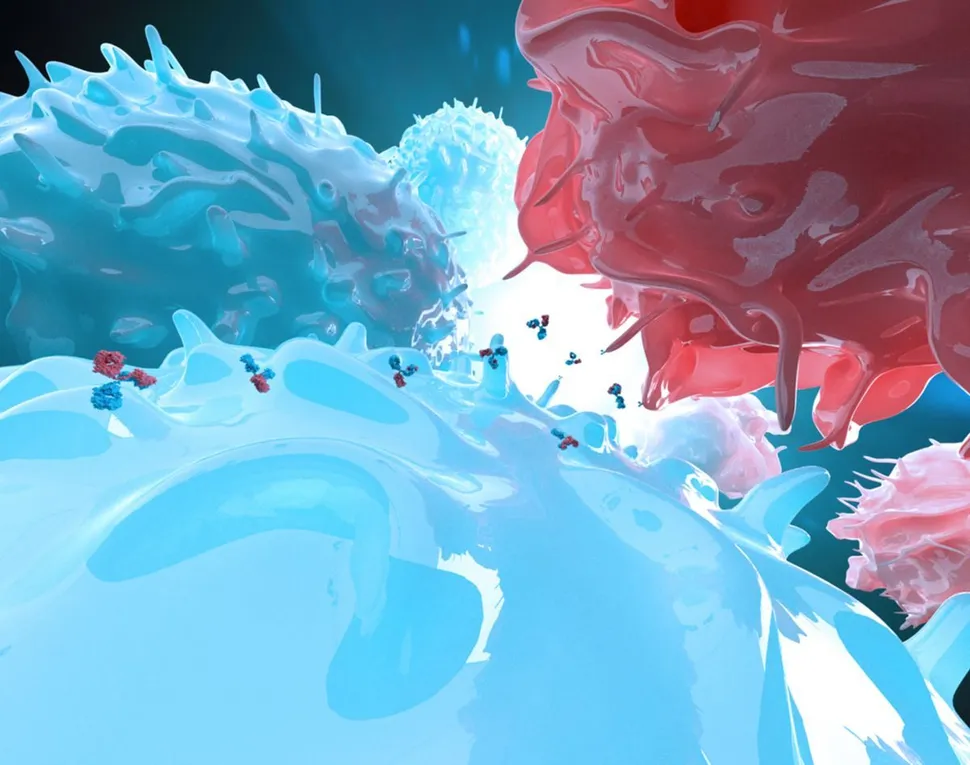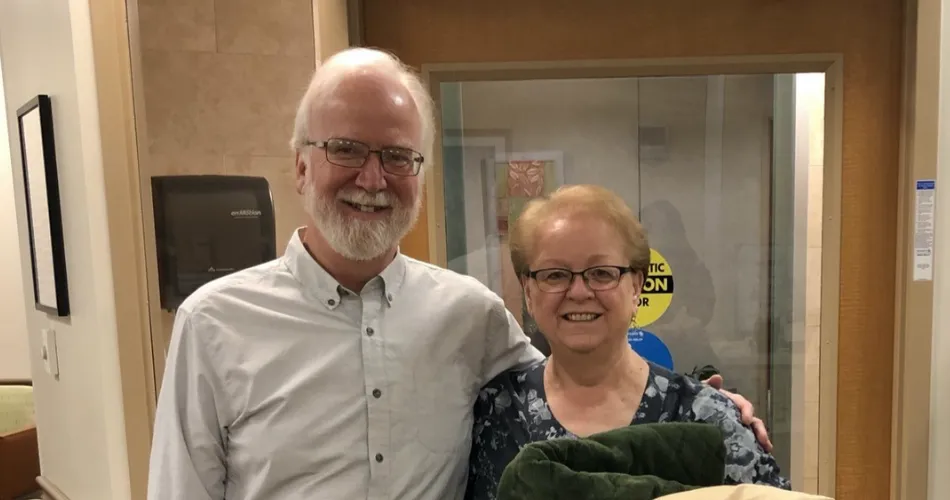Another Bi-Specific Antibody for Multiple Myeloma Treatment

It seems that hardly a week goes by without news of progress in the fight against multiple myeloma. This time it comes (again) from Johnson & Johnson, the marketers of Darzalex, with the compound teclistamab, also identified as JNJ—64007957. Teclistamab is a bi-specific antibody that binds the protein CD3 on T-cells (the cells that will do the heavy lifting against the MM cells) to BCMA (B-Cell Maturation Agent), another protein, on the cancerous cells. This tight crosslink increases the ‘killing’ efficiency of the T-cell against our disease.
Dr. Saad Usmani, the lead investigator, reported on the most recent results from the Phase I clinical study, in relapsed/refractory myeloma at the most recent virtual ASCO meeting. Remember that part of the effort in a Phase I study is to determine the range of dosing that can be safely administered and to also define the dose level(s) that will be used in later phases of the clinical programs and that will serve patients in the future. The team of investigators reported results on the first 78 patients, split over different groups for a given dose. The results are encouraging for all of us:
- The group of patients in the trial had been heavily pretreated for myeloma. The median number of prior treatment regimens was 6, and patients had become refractory to both a proteasome inhibitor (such as, e.g., Velcade, Ninlaro, Kyprolis) and an immunomodulator (such as, e.g., Revlimid, Pomaylyst, Thalomid). To be even more specific : “Overall, 72% of participants were triple-class exposed, 62% triple-class refractory, and 51% penta (five)-drug refractory.” In other words, these were patients who had come closer towards running out of treatment options.
- The drug became active at a dose level of 38.4 microgram/kg (body weight) and that kept 52 of the original 78 patients in the study. 38 percent of the patients responded to this dose level and higher
- More interestingly was that 2/3 of the 12 patients who received the highest dose of 270 microgram/kg responded to the drug, with 5 out of 12 resulting in a Very Good Partial Response, and 3 out of 13 patients achieving a Complete Response. 2 patients were MRD-negative per next generation sequencing at a level of detection of 1 cancerous cell per one million cells tested, and with treatment still ongoing after 12 months
- Responses were more durable with higher doses of the drug
- Responses were deep and persistent at the time of data cutoff with 16 out of 21 patients continuing to respond
- Several side effects have been reported. Specifically:
“The most common adverse events (AEs) of all grades were cytokine release syndrome (CRS; 56%), neutropenia (26%), and anemia (23%). CRS typically occurred during the initial doses, and all CRS events were grade 1-2. Additionally, 8% of patients experienced a treatment-related neurotoxicity (grade 3 or higher, 3%) and 9% had an infusion-related reaction. A total of 61% of patients experienced an infection-related AE with 21% of them being grade 3 or higher. Reported dose-limiting toxicities were delirium (which was resolved after 16 days) and thrombocytopenia (resolved after 1 day).”,
None of these side effects should come as a surprise to us multiple myeloma patients. We have most likely already been at the whipping end of some or many of these in our treatments to date. [I do wish, though, that someone would come up with a word that is different from ‘treatment’, as none of it is actually a ‘treat’. But then, we also already know that myeloma is not for ‘sissies’, and so we just soldier on.]
Teclistamab is in a race, though, against other companies that also have investigational assets in the BCMA-target area. One publication summarized the race as follows :
“The bar in the BCMA space is likely to be high, though. Late last year, Bristol Myers presented data showing the high dose of the anti-BCMA bispecific it picked up in its takeover of Celgene triggered responses in 89% of patients. Around half the responses were complete. Other groups have also shown early signs of efficacy. GlaxoSmithKline’s antibody-drug conjugate belantamab mafodotin is at the front of the broader pack of BCMA candidates, with the FDA granting it priority review in January and then dealing a blow to its cell therapy rival ide-cel by issuing a refuse-to-file letter to bluebird bio and Bristol Myers. However, with the response rate across the belantamab pivotal program ranging from 31% to 60%, GSK may be pushed to the fringes by assets that come to market later but with superior efficacy data. J&J could file for approval of its anti-BCMA CAR-T—which achieved a 100% response rate in one study—this year, giving it a shot at wiping out any first-mover advantage enjoyed by GSK. In teclistamab, J&J has an opportunity to also carve out a niche among patients in whom an antibody is the preferred modality, but it will face stiff competition.”
Having an offering of different options available is good for us, patients. I hope that the competition in this area will also be reflected in more pricing competitiveness to benefit us all.
It seems that hardly a week goes by without news of progress in the fight against multiple myeloma. This time it comes (again) from Johnson & Johnson, the marketers of Darzalex, with the compound teclistamab, also identified as JNJ—64007957. Teclistamab is a bi-specific antibody that binds the protein CD3 on T-cells (the cells that will do the heavy lifting against the MM cells) to BCMA (B-Cell Maturation Agent), another protein, on the cancerous cells. This tight crosslink increases the ‘killing’ efficiency of the T-cell against our disease.
Dr. Saad Usmani, the lead investigator, reported on the most recent results from the Phase I clinical study, in relapsed/refractory myeloma at the most recent virtual ASCO meeting. Remember that part of the effort in a Phase I study is to determine the range of dosing that can be safely administered and to also define the dose level(s) that will be used in later phases of the clinical programs and that will serve patients in the future. The team of investigators reported results on the first 78 patients, split over different groups for a given dose. The results are encouraging for all of us:
- The group of patients in the trial had been heavily pretreated for myeloma. The median number of prior treatment regimens was 6, and patients had become refractory to both a proteasome inhibitor (such as, e.g., Velcade, Ninlaro, Kyprolis) and an immunomodulator (such as, e.g., Revlimid, Pomaylyst, Thalomid). To be even more specific : “Overall, 72% of participants were triple-class exposed, 62% triple-class refractory, and 51% penta (five)-drug refractory.” In other words, these were patients who had come closer towards running out of treatment options.
- The drug became active at a dose level of 38.4 microgram/kg (body weight) and that kept 52 of the original 78 patients in the study. 38 percent of the patients responded to this dose level and higher
- More interestingly was that 2/3 of the 12 patients who received the highest dose of 270 microgram/kg responded to the drug, with 5 out of 12 resulting in a Very Good Partial Response, and 3 out of 13 patients achieving a Complete Response. 2 patients were MRD-negative per next generation sequencing at a level of detection of 1 cancerous cell per one million cells tested, and with treatment still ongoing after 12 months
- Responses were more durable with higher doses of the drug
- Responses were deep and persistent at the time of data cutoff with 16 out of 21 patients continuing to respond
- Several side effects have been reported. Specifically:
“The most common adverse events (AEs) of all grades were cytokine release syndrome (CRS; 56%), neutropenia (26%), and anemia (23%). CRS typically occurred during the initial doses, and all CRS events were grade 1-2. Additionally, 8% of patients experienced a treatment-related neurotoxicity (grade 3 or higher, 3%) and 9% had an infusion-related reaction. A total of 61% of patients experienced an infection-related AE with 21% of them being grade 3 or higher. Reported dose-limiting toxicities were delirium (which was resolved after 16 days) and thrombocytopenia (resolved after 1 day).”,
None of these side effects should come as a surprise to us multiple myeloma patients. We have most likely already been at the whipping end of some or many of these in our treatments to date. [I do wish, though, that someone would come up with a word that is different from ‘treatment’, as none of it is actually a ‘treat’. But then, we also already know that myeloma is not for ‘sissies’, and so we just soldier on.]
Teclistamab is in a race, though, against other companies that also have investigational assets in the BCMA-target area. One publication summarized the race as follows :
“The bar in the BCMA space is likely to be high, though. Late last year, Bristol Myers presented data showing the high dose of the anti-BCMA bispecific it picked up in its takeover of Celgene triggered responses in 89% of patients. Around half the responses were complete. Other groups have also shown early signs of efficacy. GlaxoSmithKline’s antibody-drug conjugate belantamab mafodotin is at the front of the broader pack of BCMA candidates, with the FDA granting it priority review in January and then dealing a blow to its cell therapy rival ide-cel by issuing a refuse-to-file letter to bluebird bio and Bristol Myers. However, with the response rate across the belantamab pivotal program ranging from 31% to 60%, GSK may be pushed to the fringes by assets that come to market later but with superior efficacy data. J&J could file for approval of its anti-BCMA CAR-T—which achieved a 100% response rate in one study—this year, giving it a shot at wiping out any first-mover advantage enjoyed by GSK. In teclistamab, J&J has an opportunity to also carve out a niche among patients in whom an antibody is the preferred modality, but it will face stiff competition.”
Having an offering of different options available is good for us, patients. I hope that the competition in this area will also be reflected in more pricing competitiveness to benefit us all.

about the author
Paul Kleutghen
I am a patient diagnosed in 2014 with primary plasma cell leukemia (pPCL), a rare and aggressive variant of multiple myeloma and have been very fortunate to find successful treatment at the division of Cellular Therapy at the Duke University Cancer Institute. My wife, Vicki, and I have two adult children and two grandsons who are the ‘lights of our lives’. Successful treatment has allowed Vicki and I to do what we love best : traveling the world, albeit it with some extra precautions to keep infections away. My career in the pharmaceutical industry has given me insights that I am currently putting to use as an advocate to lower drug pricing, especially prices for anti-cancer drugs. I am a firm believer that staying mentally active, physically fit, compliant to our treatment regimen and taking an active interest in our disease are keys to successful treatment outcomes.
More on Treatment Advances
Trending Articles




Get the Latest Multiple Myeloma Updates, Delivered to You.
By subscribing to the HealthTree newsletter, you'll receive the latest research, treatment updates, and expert insights to help you navigate your health.
Together we care.
Together we cure.
3x Faster.











